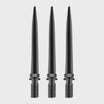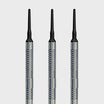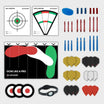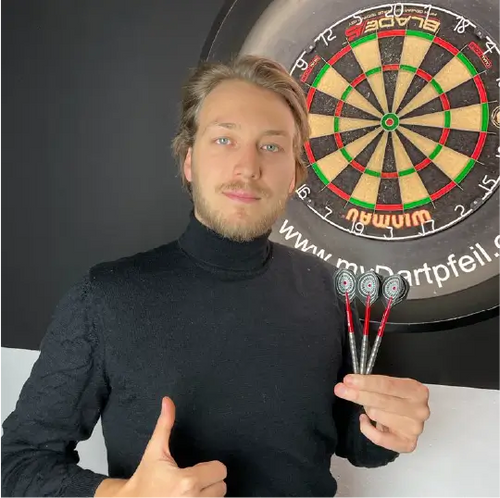Many beginners and darts players are looking for ways to reach the next level in darts training. Of course, it's not quite that simple. However, there is a personalized training formula that can help a beginner quickly improve their darts skills. Figuring out what this formula looks like often requires a lot of patience and a considerable amount of time. We'd like to offer an insight into five training options that, with regular practice, will quickly lead to success.

Tip 1: Find the right position at the oche
Aside from the actual throwing, many players don't realize that the quality of their game improves significantly when they adjust their stance by just a few centimeters. However, with a simple trick, you can quickly figure this out. Using two tack pins or nails, stretch a thin thread from the bullseye to the top of the double 20 —centered, of course.
Now throw a few times and make a tally by hand or digitally. You note whether the dart lands on the five, the left side of the halved 20, the right side of the halved 20, or the one. This dart training method allows you to quickly figure out where you subconsciously tend to throw the dart. It also achieves another effect.
Without the taut string, you often only train for the 20-meter segment. This way , however, you practice throwing in the middle of the 20s and thus obtain a much more meaningful result than without this string. So, if the arrow hits the five or the left side of the 20 disproportionately often, you can quickly correct your stance a few centimeters to the right. The reverse also works, of course.
We were surprised by the results. So, you can improve your quality with a simple trick during darts training. Try it out and see for yourself!

Tip 2: 100 darts on one field during darts training
Our second darts training tip builds on the first. The goal is to hit a number as often as possible with 100 throws (arrows) . A single scores one point, a double scores two points, and a triple scores three. If you miss, you receive zero points. The points are added after each shot. While this game isn't new, there are always very different opinions about what number of hits is considered good for a beginner.

In our opinion, 80 points is quite a challenging target for a beginner with 100 darts. For a long-time recreational player, 120 points is certainly a high hurdle. This darts training game can ultimately be applied to any area on the board. This allows you to quickly find out which numbers actually suit you best. Often, you only practice the numbers 18 to 20.
It's a shame when, after 100 darts, you realize that the 17 or 16 works much better than the three highest squares on the board. Ultimately, the score is what counts, no matter which square you score it on.
Tip 3: Double training with opponent
Doubles practice is arguably one of the most difficult exercises in darts training. It's rare that you experience the same pressure in darts training as you would in a real match. At home, alone in front of the board, you can often hit the double at will. However, under pressure, the dart sometimes simply doesn't fly into the narrow area.

A very simple method provides relief. All you need to simulate a similar pressure situation is the best possible opponent . Time and again, one observes the phenomenon in darts of significantly weaker players improving against better players and reaching their peak. This ultimately proves how much your head counts in darts . Self-confidence is ultimately the be-all and end-all .
But now to the darts training itself. Instead of just hitting 501 points over and over again, you should try hitting the doubles from the one to the bullseye as quickly as possible . If one player hits, they can aim for the next number. The other player continues to throw at the number until they also hit and can move on to the next number.
With this method, you'll quickly realize how closely the highs and lows of darts are intertwined in the mental sport. Even after a good start, it often happens that the leading player gets stuck on a tricky double, allowing the opponent to get back to it. It's certainly interesting to observe yourself during dart practice. This way, you'll maintain control over yourself and be better at hitting the double in your next real match.
Tip 4: Increase quality by changing fields
As nice as a 180 or a 171 is, it's not very meaningful. This sentence sounds brutal at first, but it shouldn't be taken too seriously. However, one thing should be emphasized : Every 171 across the T20, the T19, and the T18 is more indicative of your quality than a 171 achieved three times with the T19. Often, the desire to achieve a high score across a segment even further inhibits your quality.

And this is where our fourth darts training trick comes in. Even though it's difficult to focus on another dart after hitting the T20, we also recommend high score practice across different darts . This means that if you hit the T20, you should also aim for the T19 next. If I hit that, I throw the third dart at the T18.
Even though the 180 is nicer to look at, you're practicing your quality and all fields equally rather than just one field. This is especially important when, for example, you're down to 181. If the first two darts land in a T20, the following often happens: The third dart misses its target by a long way because you 're simply not used to having to concentrate on another field . You're therefore confronted with a completely new situation. This can be prevented by regularly practicing all the advanced treble segments.
Tip 5: Practice average during darts training
Even though many amateur players don't consider average to be the absolute measure of quality , it's still important to determine your average. To do this, you should first play ten legs with utmost concentration and use the overall average as a baseline. Important: Only complete the ten legs for this exercise once per day!
It's also a good idea to repeat this dart training daily, or at least three or four times a week. This way, after just a few weeks , you'll get a relatively clear overview of your normal average , which you can then put into perspective by training on different days.
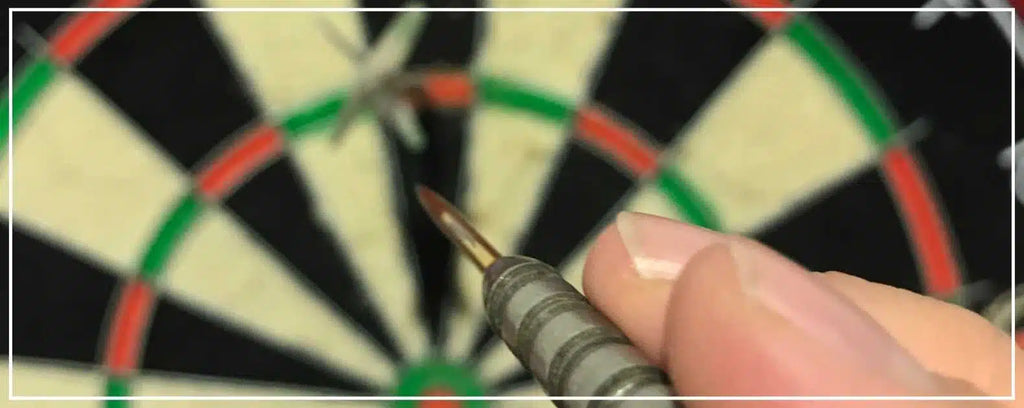
Do not distort the average
In other words, it's pointless to play the ten legs three times in one day because things are going well, and then only play the ten legs once when things are going badly. This would significantly distort your quality, regardless of your current form. The key here is to be honest with yourself to determine your absolute average .
Using this benchmark, you can then compare how your average is developing after a few weeks. This quickly shows whether you need to train more if things aren't going well for a certain period of time. Looking even further ahead, you can also derive your entire development over months or years from this type of dart training. The only important thing with this exercise is that you do it regularly .
You'll find more training games and tips in the unique myDartpfeil book . It also includes a warm-up program and an intelligent Excel spreadsheet for tracking your training results. A must-have for every darts enthusiast!
Have fun trying them out! Let us know if our dart training tips have helped you improve your performance – game on!
Ready to take your skills to the next level? Discover our exclusive secrets and proven methods to optimize your game:
- Here you can learn more about the rules of soft darts , as well as their dimensions and history. Click here to refresh your knowledge of soft dart rules!
- Dart Elimination » We explain the rules of darts and introduce you to the most popular variations. You can find all the information here. Click here now!
Sofern nicht anders angegeben, unterliegt das im Beitrag gezeigte Bildmaterial mit Bezug zu Dartspielern und verwandten Themen dem Copyright der Professional Darts Corporation (© PDC).













